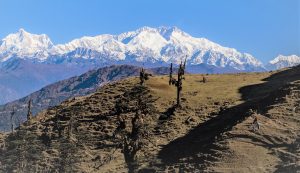A vast expanse of mountains in Asia will be among the worst hit by global climate change resulting in increased environmental hazards and insecurity to millions of people.
According to the recently released Climate Change 2022: Impacts, Adaptation and Vulnerability, which was compiled by the Intergovernmental Panel On Climate Change (IPCC), “Projected changes in hazards, such as floods and landslides, as well as changes in the water cycle, will lead to severe risk consequences for people, infrastructure and the economy in many mountain regions (high confidence). These risks will be more pervasive and also increase more rapidly in South and Central Asia and Northwestern South America.”
The extreme vulnerability of mountains to climate change prompted the panel to compile a separate chapter for the first time in 27 years; the last time the IPCC did so was in 1995 when its second assessment report carried a section titled “Impacts of Climate Change on Mountain Regions.”
The reports evaluated the impact of climate change through a study of the ecosystems, biodiversity, and human communities at global and regional levels. It also reviewed the capacities and vulnerabilities of the natural world and human societies to adapt to climate change.
Phillipus Wester, one of the 270 authors who helped prepare the IPCC AR6 WGII report, and a lead author for the chapter on mountains, feels that the changes in the Hindu Kush Himalaya (HKH) region, will lead to severe “risk consequences” for people, key infrastructure and the economy. “Already at 1.5 degree warming this risk is high and between 2 and 2.5 degree warming this risk becomes very high, he told The Diplomat.
“This is not related to the number of people in this mountain region but due to the underlying hazard processes,” Wester said.
The mountain range is home to around 240 million people across different countries.
“Comparisons with other mountain regions is difficult, but projected future risks in the HKH (which includes the Tibetan Plateau) are a great reason for concern, as they are already high at 1.5 degree warming and will affect many people,” he warned.
The report’s findings assume importance as the number of people largely or fully dependent on water from mountains has increased worldwide from 0.6 billion in the 1960s to 2 billion in the past decade, and globally two-thirds of irrigated agriculture depends on essential runoff contributions from the mountains.
In Asia, the mountain ranges of the Himalayas, the Hindu Kush, and the Karakoram span a large distance of 2,400 kilometers across six nations and contain 60,000 square kilometers of ice. They store more water than anywhere outside the Arctic and Antarctic. The World Bank has predicted that by 2050, between 1.5 billion and 1.7 billion people in South Asia could be vulnerable to water scarcity due to climate change.
The latest report by IPCC has underscored that climate change impacts in the mountains over the past 15 decades have resulted in serious consequences for people and ecosystems in many mountain regions. Among the observed changes are increasing temperatures, changing seasonal weather patterns, reductions in snow cover extent and duration at low elevation, loss of glacier mass, and an increase in the number and size of glacier lakes.
Further, it mentions that spatial distributions of many plant species have shifted to higher elevations which is in addition to the adverse impact on the water cycles in the mountains. Combined effects of climate change, hydropower development and other human interventions have enhanced security problems and social injustice.
Agriculture has also been affected through increased exposure to hazards such as droughts and floods, changes in the onset of seasons, the timing and availability of water, increasing pests and decreasing pollinator diversity, which in turn have negatively influenced overall production, dietary diversity and nutritional value.
The new report follows similar reports over the past couple of decades that have painted a grim picture about certain regions in Asia. The Asian Development Bank had earlier warned that climate-related disasters could increase in South Asia if remedial measures were not initiated to check further deterioration of the environment.
The IPCC report is a grim reminder of governments’ failure to grasp the impending dangers from climate change in the region. It has warned that there has been limited evidence of the feasibility and long-term effectiveness of adaptation responses to address climate-related impacts and related losses and damages, including in cities and settlements experiencing changing demographics.
The panel has warned that increasing temperatures will continue to induce changes in mountain regions throughout the 21st century, with “expected negative consequences” for mountain cryosphere, biodiversity and ecosystem services. The current pace and scope of adaptation is insufficient to address future risks in mountain regions, particularly at higher warming levels.
It expects an upward shift in elevation of bioclimatic zones, decreases in area of the highest elevation zones, and an expansion of the lower zones by mid-century in regions such as the Himalayas.
The report makes a case for reducing climate risks by addressing the root causes of vulnerability, which include poverty, marginalization, and inequitable gender dynamics.

































